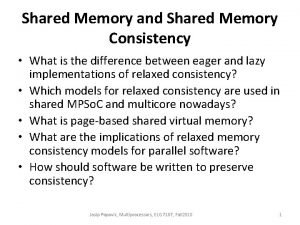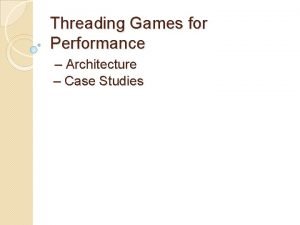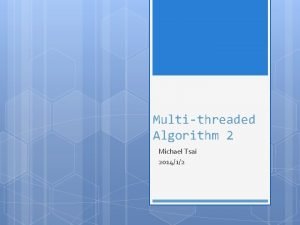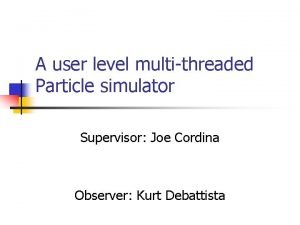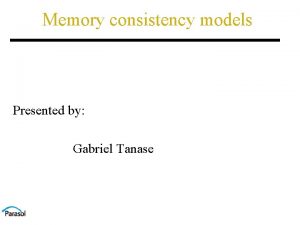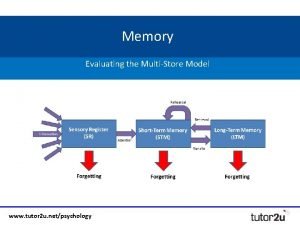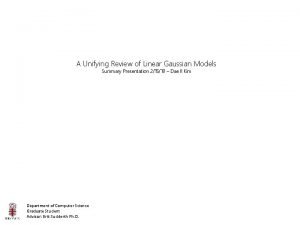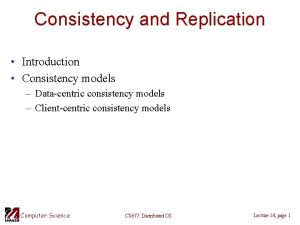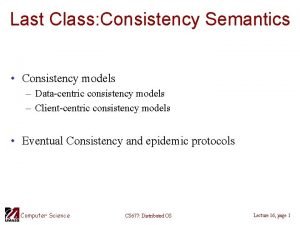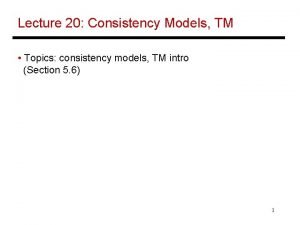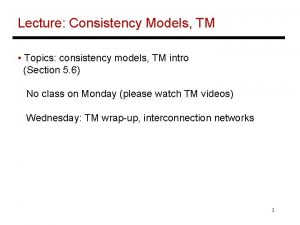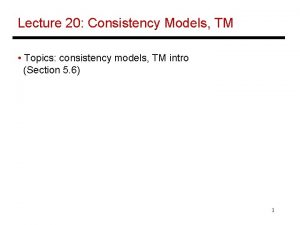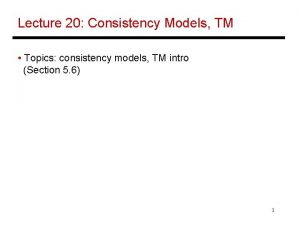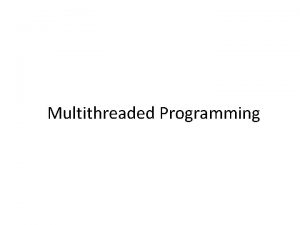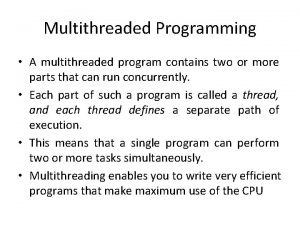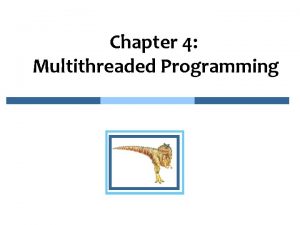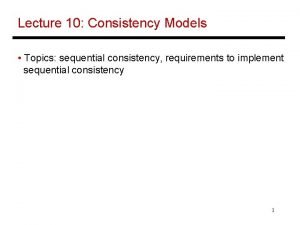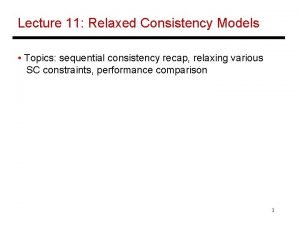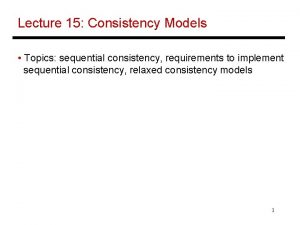Memory Consistency Models Outline Review of multithreaded program















![Simplest Memory Consistency Model • Sequential consistency (SC) [Lamport] – our canonical model: processor Simplest Memory Consistency Model • Sequential consistency (SC) [Lamport] – our canonical model: processor](https://slidetodoc.com/presentation_image/36d0466e490a501d47426d4d906c39c6/image-16.jpg)









- Slides: 25

Memory Consistency Models

Outline • Review of multi-threaded program execution on uniprocessor • Need for memory consistency models • Sequential consistency model • Relaxed memory models – weak consistency model – release consistency model • Conclusions

Multi-threaded programs on uniprocessor • • P • • • MEMORY Processor executes all threads of program – unspecified scheduling policy Operations in each thread are executed in order Atomic operations: lock/unlock etc. for synchronization between threads Result is as if instructions from different threads were interleaved in some order Non-determinacy: program may produce different outputs depending on scheduling of threads (eg) Thread 1 …. . x : = 1; x : = 2; Thread 2 …… print(x);

Multi-threaded programs on multiprocessor P P P MEMORY • Each processor executes one thread – let’s keep it simple • Operations in each thread are executed in order • One processor at a time can access global memory to perform load/store/atomic operations – no caching of global data • You can show that running multi-threaded program on multiple processors does not change possible output(s) of program from uniprocessor case

More realistic architecture • Two key assumptions so far: 1. processors do not cache global data 1. improving execution efficiency: 1. allow processors to cache global data 1. leads to cache coherence problem, which can be solved using coherent caches as explained before 2. instructions within each thread are executed in order 1. improving execution efficiency: 1. allow processors to execute instructions out of order subject to data/control dependences 1. surprisingly, this can change the semantics of the program 2. preventing this requires attention to memory consistency model of processor

Recall: uniprocessor execution • Processors reorder operations to improve performance • Constraint on reordering: must respect dependences – data dependences must be respected: in particular, loads/stores to a given memory address must be executed in program order – control dependences must be respected • Reorderings can be performed either by compiler or processor

Permitted memory-op reorderings • Stores to different memory locations can be performed out of program order store v 1, data store b 1, flag store v 1, data • Loads from different memory locations can be performed out of program order load flag, r 1 load data, r 2 load flag, r 1 • Load and store to different memory locations can be performed out of program order

Example of hardware reordering Load bypassing Store buffer Processor Memory system • Store buffer holds store operations that need to be sent to memory • Loads are higher priority operations than stores since their results are needed to keep processor busy, so they bypass the store buffer • Load address is checked against addresses in store buffer, so store buffer satisfies load if there is an address match • Result: load can bypass stores to other addresses

Problem in multiprocessor context • Canonical model – operations from given processor are executed in program order – memory operations from different processors appear to be interleaved in some order at the memory • Question: – If a processor is allowed to reorder independent operations in its own instruction stream, will the execution always produce the same results as the canonical model? – Answer: no. Let us look at some examples.

Example (I) Code: Initially A = Flag = 0 P 1 A = 23; Flag = 1; P 2 while (Flag != 1) {; }. . . = A; Idea: – P 1 writes data into A and sets Flag to tell P 2 that data value can be read from A. – P 2 waits till Flag is set and then reads data from A.

Execution Sequence for (I) Code: Initially A = Flag = 0 P 1 A = 23; Flag = 1; P 2 while (Flag != 1) {; }. . . = A; Possible execution sequence on each processor: P 1 P 2 Write A 23 Read Flag //get 0 Write Flag 1 …… Read Flag //get 1 Read A //what do you get? Problem: If the two writes on processor P 1 can be reordered, it is possible for processor P 2 to read 0 from variable A. Can happen on most modern processors.

Example II Code: (like Dekker’s algorithm) Initially Flag 1 = Flag 2 = 0 P 1 P 2 Flag 1 = 1; Flag 2 = 1; If (Flag 2 == 0) If (Flag 1 == 0) critical section Possible execution sequence on each processor: P 1 P 2 Write Flag 1, 1 Write Flag 2, 1 Read Flag 2 //get 0 Read Flag 1 //what do you get?

Execution sequence for (II) Code: (like Dekker’s algorithm) Initially Flag 1 = Flag 2 = 0 P 1 P 2 Flag 1 = 1; Flag 2 = 1; If (Flag 2 == 0) If (Flag 1 == 0) critical section Possible execution sequence on each processor: P 1 P 2 Write Flag 1, 1 Write Flag 2, 1 Read Flag 2 //get 0 Read Flag 1, ? ? Most people would say that P 2 will read 1 as the value of Flag 1. Since P 1 reads 0 as the value of Flag 2, P 1’s read of Flag 2 must happen before P 2 writes to Flag 2. Intuitively, we would expect P 1’s write of Flag to happen before P 2’s read of Flag 1. However, this is true only if reads and writes on the same processor to different locations are not reordered by the compiler or the hardware. Unfortunately, this is very common on most processors (store-buffers with loadbypassing).

Lessons • Uniprocessors can reorder instructions subject only to control and data dependence constraints • These constraints are not sufficient in shared-memory context – simple parallel programs may produce counterintuitive results • Question: what constraints must we put on uniprocessor instruction reordering so that – shared-memory programming is intuitive – but we do not lose uniprocessor performance? • Many answers to this question – answer is called memory consistency model supported by the processor

Consistency models - Consistency models are not about memory operations from different processors. - Consistency models are not about dependent memory operations in a single processor’s instruction stream (these are respected even by processors that reorder instructions). - Consistency models are all about ordering constraints on independent memory operations in a single processor’s instruction stream that have some high-level dependence (such as flags guarding data) that should be respected to obtain intuitively reasonable results.
![Simplest Memory Consistency Model Sequential consistency SC Lamport our canonical model processor Simplest Memory Consistency Model • Sequential consistency (SC) [Lamport] – our canonical model: processor](https://slidetodoc.com/presentation_image/36d0466e490a501d47426d4d906c39c6/image-16.jpg)
Simplest Memory Consistency Model • Sequential consistency (SC) [Lamport] – our canonical model: processor is not allowed to reorder reads and writes to global memory P 1 P 2 P 3 MEMORY Pn

Sequential Consistency • SC constrains all memory operations: • Write Read • Write • Read, Write - Simple model for reasoning about parallel programs - You can verify that the examples considered earlier work correctly under sequential consistency. - However, this simplicity comes at the cost of uniprocessor performance. - Question: how do we reconcile sequential consistency model with the demands of performance?

Relaxed consistency model: Weak consistency - Programmer specifies regions within which global memory operations can be reordered - Processor has fence instruction: - - all data operations before fence in program order must complete before fence is executed - all data operations after fence in program order must wait for fence to complete - fences are performed in program order Implementation of fence: - processor has counter that is incremented when data op is issued, and decremented when data op is completed - Example: Power. PC has SYNC instruction - Language constructs: - Open. MP: flush - All synchronization operations like lock and unlock act like a fence

Weak ordering picture fence program execution fence Memory operations within these regions can be reordered

Example (I) revisited Code: Initially A = Flag = 0 P 1 A = 23; flush; Flag = 1; P 2 while (Flag != 1) {; }. . . = A; Execution: – P 1 writes data into A – Flush waits till write to A is completed – P 1 then writes data to Flag – Therefore, if P 2 sees Flag = 1, it is guaranteed that it will read the correct value of A even if memory operations in P 1 before flush and memory operations after flush are reordered by the hardware or compiler. – Question: does P 2 need a flush between the two statements?

Another relaxed model: release consistency - Further relaxation of weak consistency - Synchronization accesses are divided into - Acquires: operations like lock - Release: operations like unlock - Semantics of acquire: - Acquire must complete before all following memory accesses - Semantics of release: - all memory operations before release are complete - However, - acquire does not wait for accesses preceding it - accesses after release in program order do not have to wait for release - operations which follow release and which need to wait must be protected by an acquire

Example L/S ACQ L/S REL L/S Which operations can be overlapped?

Implementations on Current Processors

Comments • In the literature, there a large number of other consistency models – processor consistency – total store order (TSO) – …. • It is important to remember that these are concerned with reordering of independent memory operations within a processor. • Easy to come up with shared-memory programs that behave differently for each consistency model. • Emerging consensus that weak/release consistency is adequate.

Summary • Two problems: memory consistency and memory coherence • Memory consistency model – what instructions is compiler or hardware allowed to reorder? – nothing really to do with memory operations from different processors/threads – sequential consistency: perform global memory operations in program order – relaxed consistency models: all of them rely on some notion of a fence operation that demarcates regions within which reordering is permissible • Memory coherence – Preserve the illusion that there is a single logical memory location corresponding to each program variable even though there may be lots of physical memory locations where the variable is stored
 Shared memory consistency models a tutorial
Shared memory consistency models a tutorial Memory consistency models in distributed systems
Memory consistency models in distributed systems Eventual consistency vs strong consistency
Eventual consistency vs strong consistency Jumlah level dalam gambar ini adalah . . . .
Jumlah level dalam gambar ini adalah . . . . Multithreaded programming languages
Multithreaded programming languages Multithreaded games
Multithreaded games Multithreaded algorithms
Multithreaded algorithms Apt multithreaded
Apt multithreaded Client centric consistency model
Client centric consistency model Client-centric consistency models
Client-centric consistency models Sequential consistency
Sequential consistency Modals and semi modals difference
Modals and semi modals difference Prototypes in semantics
Prototypes in semantics Implicit memory
Implicit memory Long term memory vs short term memory
Long term memory vs short term memory Internal memory and external memory
Internal memory and external memory Primary memory and secondary memory
Primary memory and secondary memory Logical memory vs physical memory
Logical memory vs physical memory Which memory is the actual working memory?
Which memory is the actual working memory? Virtual memory and cache memory
Virtual memory and cache memory Virtual memory in memory hierarchy consists of
Virtual memory in memory hierarchy consists of Eidetic memory vs iconic memory
Eidetic memory vs iconic memory Shared memory vs distributed memory
Shared memory vs distributed memory Tutor 2 net
Tutor 2 net Sentence outline
Sentence outline A unifying review of linear gaussian models
A unifying review of linear gaussian models

